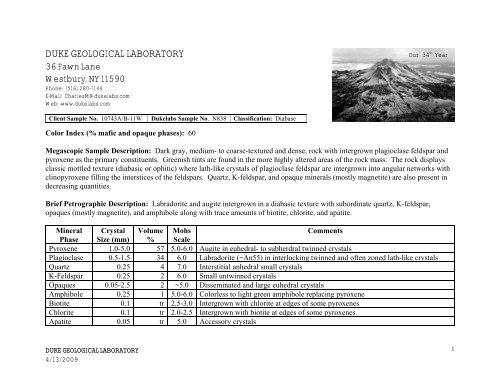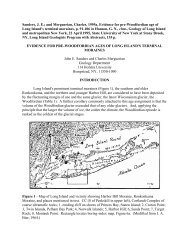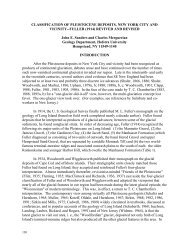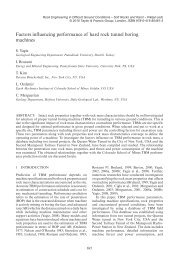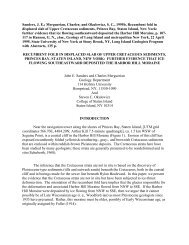Sample Igneous Report
Sample Igneous Report
Sample Igneous Report
Create successful ePaper yourself
Turn your PDF publications into a flip-book with our unique Google optimized e-Paper software.
DUKE GEOLOGICAL LABORATORY Our 34 th Year36 Fawn LaneWestbury, NY 11590Phone: (516) 280-7144E-Mail: CharlesM@dukelabs.comWeb: www.dukelabs.comClient <strong>Sample</strong> No. 10743A/B-11W Dukelabs <strong>Sample</strong> No. N838 Classification: DiabaseColor Index (% mafic and opaque phases): 60Megascopic <strong>Sample</strong> Description: Dark gray, medium- to coarse-textured and dense, rock with intergrown plagioclase feldspar andpyroxene as the primary constituents. Greenish tints are found in the more highly altered areas of the rock mass. The rock displaysclassic mottled texture (diabasic or ophitic) where lath-like crystals of plagioclase feldspar are intergrown into angular networks withclinopyroxene filling the interstices of the feldspars. Quartz, K-feldspar, and opaque minerals (mostly magnetite) are also present indecreasing quantities.Brief Petrographic Description: Labradorite and augite intergrown in a diabasic texture with subordinate quartz, K-feldspar,opaques (mostly magnetite), and amphibole along with trace amounts of biotite, chlorite, and apatite.Mineral Crystal Volume MohsCommentsPhase Size (mm) % ScalePyroxene 1.0-5.0 57 5.0-6.0 Augite in euhedral- to subherdral twinned crystalsPlagioclase 0.5-1.5 34 6.0 Labradorite (~An55) in interlocking twinned and often zoned lath-like crystalsQuartz 0.25 4 7.0 Interstitial anhedral small crystalsK-Feldspar 0.25 2 6.0 Small untwinned crystalsOpaques 0.05-2.5 2 ~5.0 Disseminated and large euhedral crystalsAmphibole 0.25 1 5.0-6.0 Colorless to light green amphibole replacing pyroxeneBiotite 0.1 tr 2.5-3.0 Intergrown with chlorite at edges of some pyroxenesChlorite 0.1 tr 2.0-2.5 Intergrown with biotite at edges of some pyroxenesApatite 0.05 tr 5.0 Accessory crystalsDUKE GEOLOGICAL LABORATORY4/13/20091
Macro and Petrographic ImagesFigure 1 – Image of sawn core from which thin section wasmade. Rock displays a medium- to coarse texture consistingpredominately of intergrown pyroxene (dark) and plagioclase(light) phases. Note thin vein of calcite cutting across upperleft part of sawn core. Greenish tints are the result of alterationto amphibole and chlorite. Thin section cut from depth of3.95’.Figure 2 - Photomicrograph showing interstitial growth oftwinned clinopyroxenes (large crystals of augite with blue andorange interference colors) grown in angular areas betweenzoned and twinned lath-like crystals of plagioclase feldspar.The feldspar is slightly weathered, internally altered to clayand sericite in some crystals. Note the triangular arrangementof feldspar crystals, typical of diabasic texture.Note: Petrographic Image (Width of Field = 1.6 mm)DUKE GEOLOGICAL LABORATORY4/13/20092
Petrographic Description and Rock Mass Properties<strong>Sample</strong> N838 consists mostly of pyroxene and plagioclase feldspar in roughly equal proportions. The pyroxene ispredominately augite and shows abundant twinning. The pyroxene is intimately associated with plagioclase to produce a diabasictexture consisting of intergrown lath-like crystals of plagioclase with the pyroxenes formed at the often angular interstices of thefeldspars. The feldspars are labradorite (~An55) and show typical polysynthetic twinning and often show oscillatory zoning. Thefeldspars are somewhat weathered and thus altered and replaced by fine intergrowths of clay and sericite. Clinopyroxene, althoughless weathered, shows slight alteration to colorless amphibole (?) along exsolution lamellae.In addition to the primary phases, subordinate K-feldspar, quartz and amphibole also occur throughout the rock and smallamounts of opaque minerals occur as disseminated crystals and larger euhedral crystals. Chlorite and biotite occur in trace amountsalong with the accessory mineral apatite.The rock mass is slightly weathered based on the condition of both the feldpars and clinopyroxenes. Overall, the rock is denseand tough to break and is representative of the world-renowned mafic Palisades intrusive sheet which is continuously exposed alongthe east edge of the Newark Basin from west of Haverstraw, New York southwestward to Staten Island, New York City.Petrographer: Charles Merguerian, Ph.D.DUKE GEOLOGICAL LABORATORY4/13/2009Filename: N838 DGL Petro <strong>Report</strong>.doc3


